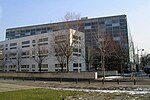Arboretum de l'Abiétinée
The Arboretum de l'Abiétinée (1.5 hectares) is an arboretum located between Rue Pasteur and the Grand Allée in Malzéville, Meurthe-et-Moselle, Lorraine, France. The garden is strongly linked to the history of French Art Nouveau but currently unmaintained. The private arboretum was created in 1902 by Eugène Schott, mayor of Malzéville and also vice president of the Société centrale d'horticulture de Nancy. Emile Gallé, a major force in the French Art Nouveau movement, concurrently served as the society's president, and the nearby Cure d'Air Trianon was, like the arboretum, designed in the Art Nouveau style. Horticulturist and conifer specialist Victor Didier designed and led planting of the garden, whose name reflects the society's interest in fir trees (Abies). According to a document by Didier, published in 1910, the garden contained 25 genera and 277 taxa of conifers, as well as a number of other woody plants. It received honors for its conifer collection in the years 1904-1913, but the property changed hands several times subsequently as the arboretum fell into disuse. As of 2006 it was in danger of loss to development, and efforts were underway to save and restore it.
Excerpt from the Wikipedia article Arboretum de l'Abiétinée (License: CC BY-SA 3.0, Authors).Arboretum de l'Abiétinée
Allée des Tourterelles, Nancy
Geographical coordinates (GPS) Address External links Nearby Places Show on map
Geographical coordinates (GPS)
| Latitude | Longitude |
|---|---|
| N 48.70836667 ° | E 6.194861111 ° |
Address
Parc de l'Abiétinée (Arboretum de l'Abiétinée)
Allée des Tourterelles
54220 Nancy
Grand Est, France
Open on Google Maps








